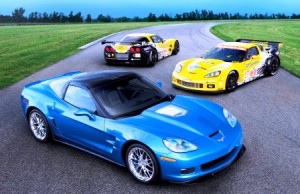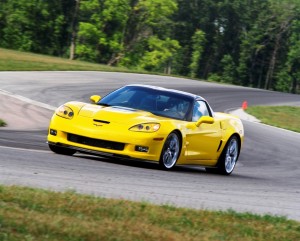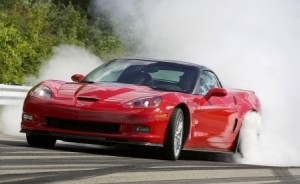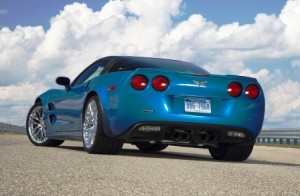
C6.R and ZR1 differ significantly are in situations where GT rules prohibited the use of the more sophisticated ZR1 components.
Corvette Racing’s second-generation C6.R will be powered by a new 5.5-liter production-based V8, to compete in the new unified GT class in the 2010 American Le Mans Series, Chevrolet said today.
Corvette C6.R will also compete in the GT2 class at the 24 Hours of Le Mans.
The updated C6.R and the Corvette ZR1 – starting at $107,000 – have a strongest link thus far between the Corvette Racing team and production Corvette. (Well, at least in recent times. ) Both cars will compete on and off the track with more expensive showroom competitors, including Aston Martins, BMWs, Porsches and Ferraris.
Corvette, of course, has a long history of production-based endurance racing, making its first appearance at the 12 Hours of Sebring in 1956, and its first appearance at Le Mans in 1960. (Click Here)
Then Corvette chief engineer Zora Arkus-Duntov used the racing program to improve the production Corvette, including the development of heavy-duty and high-performance components, as well as the introduction of the race-bred Z06 option on the 1963 Corvette Sting Ray, which remains a favorite among collectors.
The transfer of technology between racing and production cars resumed with the start of the modern Corvette Racing program in 1999.
Tadge Juechter, the current Corvette chief engineer says, “Simply put, without Corvette Racing, there would not be a Corvette Z06, much less the ZR1. And, without the foundation of the Corvette C6, Z06 and ZR1, the Corvette Racing team would not be the dominant presence in production-based racing.”
C5-R and Corvette Street performance
Corvette raced the C5-R from 1999 through the end of the 2004 season. The first-generation car scored 35 victories in 55 races, won its class at the 12 Hours of Sebring three consecutive years, posted three 1-2 finishes in the GTS class at the 24 Hours of Le Mans, and earned four consecutive ALMS manufacturers championships for Chevrolet.
It also served as a catalyst for Corvette performance. In 1999, the fifth-generation Corvette C5 produced 345 horsepower from its 5.7-liter V8. Marketing claimed, with some substance in the instance, that it used powertrain technologies developed for the C5R.
Corvette reintroduced the Z06 moniker in 2001, with a 385 horsepower 5.7-liter V8 engine. Current versions start at $75,000.
In addition, it is said, that the C5-R helped shape the sixth-generation Corvette, introduced for the 2005 model year. Corvette Racing’s influence could be seen in the C6 Corvette design, which featured flush headlights for better aerodynamics; a single, large grille opening for the engine air intake, radiator, and brake cooling; a lower coefficient of drag; and a relatively light 3,179-pound curb weight.
Lessons from racing were also integrated in the 6.0-liter LS2 V8, the most powerful standard Corvette engine to date, with 400 horsepower and 400 lb-ft of torque. As a result, the C6 Corvette delivered unprecedented performance, including a 186-mph top speed, acceleration from 0-60 mph in 4.1 seconds, and quarter-mile runs in 12.6 seconds at 114 mph. This, unless you are a total snob, was the best value in a rarefied performance world dominated by German and Italian sports cars.
C6.R and Z06
The C6 Corvette served as basis for the joint development of two new, high-performance Corvettes: the 2006 Corvette Z06 and the Corvette Racing C6.R, introduced in 2005.
Both were powered by 7.0-liter “small-block” V8 engines, with dry-sump lubrication systems, CNC-ported aluminum cylinder heads, titanium valves, forged steel crankshafts, and plate-honed cylinder bores.
For Z06 owners, this meant 505 horsepower, and 470 lb.-ft. of torque under the hood. For performance numbers pick your expletive to describe a198-mph top speed, acceleration from 0 – 60 mph in 3.7 seconds, and 11.7-second quarter-mile runs at 125 mph.
Corvette Z06 use of lightweight carbon fiber front fenders and wheelhouses, and aerodynamics package – including a front splitter, air extractors behind the front wheels, radiused trailing edges on the wheel openings, brake cooling scoops, widened rear fenders, rear diffuser, and spoiler – all racing tricks.

ZR1 aerodynamics use racing tweaks, including carbon fiber front fenders with dual vents, a full-width rear spoiler, and a front splitter.
For the C6.R, homologation from the street Z06 translated into 42 wins, four consecutive ALMS drivers and manufacturer’s championships, and three victories at the 24 Hours of Le Mans.
Gen 2 C6.R and ZR1
In the 2010 American Le Mans Series, Corvette Racing will compete in the series’ production-based GT category (formerly GT2) and in the GT2 class at the 24 Hours of Le Mans with a second-generation C6.R that is homologated on the Corvette ZR1.
The GT rules require the use of many production-based components, making the ZR1 and C6.R the closest street and racing Corvettes since the 1960s.
Introduced for the 2009 model year, the ZR1 is the fastest, most powerful car ever produced by Chevrolet. The LS9 V8 engines are hand-built using many of the processes developed by the race team. Rated at 638 horsepower, the V8 impels a 205-mph top speed. Naturally, the ZR1 aerodynamics package also uses racing technology – including carbon fiber front fenders with dual vents, a full-width rear spoiler, and a front splitter.
The updated C6.R uses the ZR1 body design, aerodynamic package, aluminum frame and chassis structure, steering system, windshield, and other components.
Aluminum frame: The new Corvette C6.R is built on the same aluminum frame rails that underpin production Corvette Z06 and ZR1 models. Other production chassis structures in the racecar include the windshield frame, the hoop around the rear of the passenger compartment, the door hinge pillars, the drivetrain tunnel, the firewall, and the floor pan.
Steering system: The new Corvette C6.R uses the production steering column out of the ZR1, with a fully adjustable steering wheel, and production rack-and-pinion steering rack.
Body profile: The Corvette C6.R racecar is now virtually identical to the Corvette ZR1 streetcar in appearance, as GT rules require production-type fenders with simple flares to accommodate wider tires.
Aerodynamics: The new C6.R uses the full-width, production rear spoiler from the ZR1, and a production-based ZR1 front splitter that extends 25mm, in contrast to the 80mm splitter allowed under the GT1 rules. Although the aerodynamics package does not produce the same levels of downforce as the GT1 car, the C6.R is more predictable over a wide range of speeds.
Where the C6.R and ZR1 differ significantly are in situations where GT rules actually prohibited the more sophisticated ZR1 components. For example, the ZR1 is equipped with carbon-composite brake rotors, while GT regulations require steel brake discs. In addition, where the ZR1 uses a 6.2-liter, supercharged V8, the C6.R will use a naturally aspirated small-block, production-based 5.5-liter V8.
The Corvette C6.R 5.5-liter Chevrolet small-block V8 engines are developed, built and maintained by GM. The Corvette C6.Rs’ LS5.5R is a naturally aspirated race engine, based on the Corvette Z06’s 7.0-liter LS7 engine (which in turn was developed with the 7.0-liter race engine used in the C6.R GT1 cars), built on production cast-aluminum cylinder blocks.
Pending GT2 class regulations specify a maximum displacement of 5.5 liters, the reduction in displacement to meet this requirement was achieved by shortening the crankshaft stroke and reducing the cylinder bore diameter. In accordance with regulations, the race engines have two 28.8mm-diameter intake air restrictors. The LS5.5R engines are equipped with dry-sump oiling systems, CNC-ported aluminum cylinder heads with titanium intake and exhaust valves, and sequential electronic port fuel injection. The race engines use E85R ethanol racing fuel in the ALMS and E10 fuel in Le Mans.
Race on Sunday, Sell on Monday?
“Corvette sales tracked directly to customer leads at ALMS races have doubled from 2005 to 2009,” says John Fitzpatrick, Chevrolet Performance Cars marketing manager. “This proves what we have heard anecdotally from other Corvette owners: Watching production-based Corvettes win against legendary marques like BMW, Porsche and Ferrari, on legendary tracks like Sebring and Le Mans, makes Corvette all the more desirable.”
Corvette also has an $60,000 model, The Gradn Sport. (Click Here)
–
| 2010 Corvette ZR1 | 2010 GT2 Corvette C6.R | |
| Displacement (L / ci): | 6.2 / 376 | 5.5 / 336 |
| Horsepower: | 638 @ 6500 rpm | 485 @5800 |
| Torque (lb-ft): | 604 @ 3800 rpm | na |
| Bore diameter (mm / in): | 103.25 / 4.06 | 103.89 / 4.090 |
| Crankshaft stroke (mm / in): | 92 / 3.62 | 80.90 / 3.185 |
| “V” angle (deg): | 90 | 90 |
| Cylinder bore spacing (mm / ci): | 111.7 / 4.40 | 111.7 / 4.40 |
| Valvetrain: | pushrod with overhead valves, titanium inlet | pushrod overhead valves, titanium inlet and exhaust |
| Valves per cylinder: | 2 | 2 |
| Camshaft drive: | chain | chain |
| Cylinder case material: | aluminum | aluminum |
| Cylinder liners: | dry iron | aluminum |
| Cylinder head material: | aluminum | aluminum, CNC ported |
| Lubrication system: | dry sump | dry sump |
| Fuel system: | sequential EFI | sequential EFI |
| Throttle system: | supercharged w/intercooler, throttle body | individual runner |
| Fuel: | premium unleaded gasoline required | E85R ethanol (ALMS) E10 (Le Mans) |
| Body style: | two-door hatchback coupe | two-door hatchback coupe |
| Drivetrain: | longitudinal front engine, rear-wheel drive | longitudinal front engine, rear-wheel drive |
| Chassis: | hydroformed aluminum chassis, composite body | hydroformed aluminum chassis, composite body |
| Wheelbase (in): | 105.7 | 105.7 |
| Length (in): | 176.2 | 176.2 |
| Width (in): | 75.9 | 78.6 |
| Height (in): | 49 | 45.9 |
| Weight (lb): | 3324 | 2745 |
| Front suspension: | independent, short/long arm double wishbone, cast aluminum controls, transverse-mounted composite leaf spring, monotube shock absorbers, anti-roll bar | independent, short/long double wishbone, fabricated steel upper & lower, machined aluminum knuckle, coil-over multi-adjustable shock absorbers, anti-roll bar |
| Rear suspension: | independent, short/long arm double wishbone, cast aluminum control arms, transverse-mounted composite leaf spring, monotube shock absorbers; anti-roll bar | independent, short/long arm double wishbone, steel fabricated upper & lower control arms, machined aluminum knuckle, coil-over multi-adjustable shock absorbers, anti-roll bar |
| Brakes: | front and rear power-assisted carbon-ceramic disc with 6-piston front and 4-piston rear calipers, cross-drilled rotors, ABS | 4-wheel disc with monoblock calipers, steel rotors and ceramic composite pads |
| Wheels (in): | 19 x 10 (front); 20 x 12 (rear) | 18 x 12.5 (front); 18 x 13 (rear) |
| Tires: | Michelin Pilot Sport 2P285/30ZR19 (front)P335/25ZR20 (rear) | Michelin racing tires,300/32-18 (front) 310/41-18 (rear) |
| Fuel capacity (gal): | 18 | 26.4 (29 @ ALMS E85R spec) |
–


